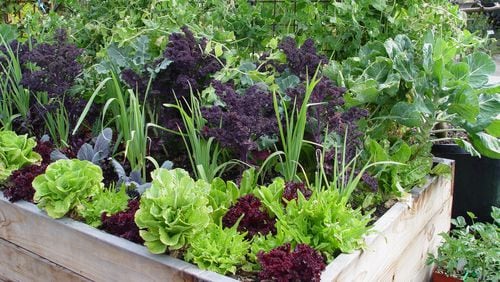The secret season in your food garden is fall crops in the warm West. Because frost doesn’t come to many areas until quite late, there’s a lot of growing time now.
As everything from summer is dying, the leaf-bearing plants such as kale and root-bearing ones like beets are thriving. These plants don’t need long days to flower and set fruit. The moment your kale produces leaves they are ready to cut and eat. Plants grown for leaf and root are planted from seed at summer’s end, or buy well started seedlings if you start too late. The moment the greens are large enough to pick you’ll enjoy a daily supply of cooking greens for the kitchen that increases every week.
Once established, some of the winter greens such as kale are quite frost-tolerant. Many aficionados believe kale greens grow sweeter after being touched by frost. In the cool fall, kale is less vulnerable to the wooly aphids that flock to them in the summer.
Row covers are the best way to grow greens in any season. Hoops and covers are now available through most organic gardening catalogs. This method is actually a season extender for organic market gardeners to keep their greens clean and producing as deep into winter as possible. In milder winters, row covers ensure you have fresh greens all winter long to snip and sear and enjoy.
Covers also keep the leaves clean and free of insects for easy preparation. Dry fall winds won’t desiccate them as much either. Row covers also allow you to grow the less cold hardy greens as well for lots of diversity in the holiday kitchen.
While everyone is all excited about kale these days, consider lesser known winter greens that add more depth of flavor, different cooking times and vivid colors.
Swiss chard is unique in that it’s a pot green that cooks very quickly. The leaves have no bitterness, so you can sauté them in olive oil with any other ingredients you like. A whole meal can be created in just a few minutes using fresh-picked organic greens as the basis for impromptu dishes. Its texture is perfectly suited to serving with quinoa for light and nutritious dining. For large families, grow the Fordhook Giant, with huge leaves and wide stems cooked just like celery.
Beets are the unknown green disguised as a root crop. In fact, beet greens are so popular some varieties are expressly developed for larger foliage heads rather than an improved root. Beet greens cook just like chard, so they make a very compatible combination with the reddish tints added to your dishes from the vividly colored leaves. Harvest often during the maturation process, then dig the beet root and enjoy that as your season’s end bonus.
Off-season vegetable gardening is a new trend in America that extends food gardening well beyond the summer to ensure a perpetual harvest. That soil has supported one group of plants this year, so add all the compost you can after you remove the declining or dead plants that have finished their work. Till and amend that ground to build it up again for immediate replanting.
Make sure your soil is well prepared with plenty of nitrogen, the nutrient responsible for leaf and stem growth. Use composted steer manure, alfalfa meal or fish emulsion to ramp up nitrogen at planting time for this new fall garden.
Once you discover how useful winter greens are, you’ll never go into fall without planting your winter greens. Cool weather and rain keep them thriving with or without row covers. Use a Planket or bed sheet on very cold nights to keep the outdoor plants warm or grow protected under row covers. While everyone else is pawing through wilted leaves in the supermarket, all you have to do is go out and pick, stir-fry and enjoy fast food until it’s time to replant them all at winter’s end.
———
Maureen Gilmer is an author, horticulturist and landscape designer. Learn more at www.MoPlants.com






